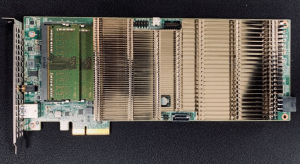IBC 2019: Intel’s Lynn Comp on how global video demand requires new hardware and software solutions
Millions of data centers and telecom towers strategically placed across the planet, over 885,000 kilometers of undersea cable, billions of devices, and nearly all of it in service of one thing: online video.
According to Cisco, IP video traffic will be 82 percent of all IP traffic in the world by 2022, increasing by four-fold since 2017. Video on demand alone is doubling in the same period, an amount equal to 10 billion DVDs per month. Service providers need platforms that can scale in order to accelerate services and meet what has become an insatiable demand. The vast majority of visual cloud services are delivered today on Intel (stand 15.Ms30) Xeon Scalable processors, with powerful and flexible open source software delivering scalable transcode, analytics, and more. In some circumstances, hardware accelerators may be useful to address density and power requirements; for example, at the edge where latency and bandwidth are advantaged and power and real estate are at a premium.
Efficiently scaling video processing and distribution requires hardware and software optimized for specific workloads, and Intel is at the forefront of both, investing in scalable architectures to accelerate innovation.
 Hardware Accelerators
Hardware Accelerators
At IBC 2019, Intel is proud to announce two new hardware products to help meet global video demand. Joining Intel’s diverse, world-class processors are two PCIe card accelerators specifically designed for visual cloud workloads.
First, the Intel Visual Cloud Accelerator Card – Analytics (VCAC-A) is optimized for the highest density offload acceleration for use in network edge servers. The new acceleration solution combines both on-card decode and video inference acceleration, along with high efficiency, FP16 precision that can manage 24 streams at 1080p 30FPS, up to 144 streams per server with six cards.
Second, the Intel Visual Cloud Accelerator Card – Render (VCAC-R) is optimized for cloud gaming, graphics, VR, and virtual desktops. With high performance rendering and encoding, low latency, competitive 3D performance, and multiple Windows games per card, VCAC-R can handle four Windows game streams at 1080p 30FPS, and at 720p 30FPS can handle 20 Android game streams.
Both accelerators are available today from our ODM partner Celestica and, like the previously released PCIE-7217 from SMART Embedded Computing (formerly Artesyn), are the result of Intel’s close collaboration with ecosystem partners to produce targeted hardware that can handle the most challenging demands of video delivery today.
In partnership with SMART Embedded Computing and Gamestream, Intel will host a cloud gaming demonstration at IBC this year to show how AAA games can achieve low latency (25ms including 10ms network latency) with the SMART Embedded Computing MaxCore™ rendering system, which can host up to 15 SMART EC PCIE-7217 cards, supporting up to 58 concurrent gamers.
Open Software
Hardware is only one half of the video delivery equation; software is just as important. In a recent blog, Intel’s Lynn Comp wrote about how focusing on bit rate reduction through software can result in drastic TCO benefits. Intel continues to invest heavily in several software projects that target key steps along the data journey. The Open Network Edge Services Software (OpenNESS) and Open Visual Cloud are two of the many initiatives at Intel towards this end.
First announced by Intel at Mobile World Congress, OpenNESS is an open source software toolkit to enable easy orchestration and management of edge services in multi-cloud environments. With OpenNESS, applications developers get a network “easy button” for extending applications from the cloud to the edge, while service providers have a system that helps them create and manage a scalable app ecosystem.
Open Visual Cloud leverages a modular interoperable approach to software supporting core decode, inference, render, and encode functionality with optimized open source ingredients such as Scalable Video Technology (SVT), OpenVINO™ Toolkit, and the oneAPI Rendering Framework. In addition, several different sample reference pipelines for visual cloud services are provided as Docker files and images so that service providers can get started quickly to deploy customized services without further platform investments.
Intel is updating two new Open Visual Cloud reference pipelines for release at IBC 2019, including:
- Smart City: The smart city reference pipeline shows how to integrate various media building blocks, with analytics powered by the OpenVINO™ Toolkit, to accelerate converged media pipelines. This is a smart city planning sample that can be referenced to ease application development challenges.
- Ad-insertion: The intelligent ad-insertion reference pipeline shows how to integrate various media building blocks, with analytics powered by the OpenVINO™ Toolkit, to accelerate converged media pipelines. This is a server-side ad insertion sample that can be referenced by developers, now supported on the Intel VCAC-A accelerator card.
Intel Select Solutions
Of course, it’s when hardware and software elements are strategically combined that the full potential of optimization can be realized. Intel Select Solutions consist of optimized bundled hardware and software recipes to deploy workloads easily and meet performance thresholds for a premium customer experience. The first of these solutions for the visual cloud market was designed to meet the rapidly emerging needs for content delivery networks (CDNs). Intel Select Solutions for Visual Cloud Delivery Network are now available through Quanta Cloud Technology.
At IBC 2019, we are continuing our commitment to these solutions by announcing that the new Intel Select Solutions for Media Analytics powered by Intel Xeon processors and Intel QuickAssist Technology for software-enabled security, authentication, and compression will be available soon. Available in Base and Plus configurations, the Plus configuration will take advantage of the newly announced VCAC-A. Like all of the other Intel Select Solutions, the latest offering is a rigorously benchmark tested and verified solution optimized for real-world performance.
